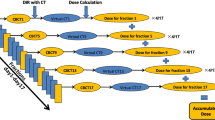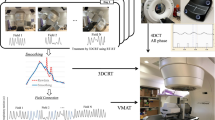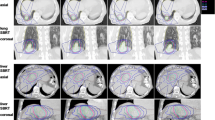Abstract
Purpose
We investigated the changes in dose distribution of three-dimensional conformal radiotherapy (3D CRT) during lung tumor treatment.
Materials and Methods
Ten patients with non-small cell lung cancer who had undergone planning for radical radiotherapy were selected for study. Computed tomography (CT) examination was performed at two time intervals during the course of conformal radiotherapy: t0 Gy at the time of planning and t40 Gy at 40 Gy of treatment. We transferred all the planed beam data at t0 Gy to each t40 Gy CT image. The isodose distribution was recalculated at time t40 Gy for the same beam characteristics. Variations in volumes and dose-volume histograms (DVHs) were analyzed and compared for lung, gross target volume (GTV), and planning target volumes (PTV) between t0 Gy and t40 Gy. A paired t-test was performed to compare the DVH between t0 Gy and t40 Gy.
Results
The mean minimum doses for t40 Gy GTV, and PTV were lower than t0 Gy. However, there was no significant difference between t0 Gy and t40 Gy (p=0.493, 0.378, respectively). There was a patient whose minimum doses of GTV and PTV were decreased and who had notable improvement of lobar atelectasis after 40 Gy of radiotherapy. Comparison of the percent volume of received dose exceeding 20 Gy (V20) and the mean dose for the total lung revealed that t40 Gy was larger than t0 Gy (p=0.013, 0.012).
Conclusion
Incorporation of the time factor into 3D treatment planning is mandatory for frequent reiteration of treatment planning during treatment periods. Clearly, more work in this area should be considered.
Similar content being viewed by others
References
Uematsu M, Shioda A, Tahara K,et al. Focal, high dose, and fractionated modified stereotactic radiation therapy for lung carcinoma patients: a preliminary experience.Cancer, 82: 1062–1070, 1998.
Balter JM, Ten Haken RK, Lawrence TS,et al. Uncertainties in CT-based radiation therapy treatment planning associated with patient breathing.Int J Radiat Oncol Biol Phys, 36: 167–174, 1996.
Balter JM, Lam KL, McGinn CJ,et al. Improvement of CT-based treatment-planning models of abdominal targets using static exhale imaging.Int J Radiat Oncol Biol Phys, 41: 939–943, 1998.
ICRU Report 62.International Commission on Radiation Units and Measurements. Prescribing, recording and reporting photon beam therapy (Suppl to ICRU Report 50), 1999.
Langen KM, Jones DT. Organ motion and its management.Int J Radiat Oncol Biol Phys, 50: 265–278, 2001.
Ross CS, Hussey DH, Pennington EC,et al. Analysis of movement of intrathoracic neoplasms using ultrafast computerized tomography.Int J Radiat Oncol Biol Phys, 18: 671–677, 1990.
Shimizu S, Shirato H, Kagei K,et al. Impact of respiratory movement on the computed tomographic images of small lung tumors in three-dimensional (3D) radiotherapy.Int J Radiat Oncol Biol Phys, 46: 1127–1133, 2000.
Ekberg L, Holmberg O, Wittgren L,et al. What margins should be added to the clinical target volume in radiotherapy treatment planning for lung cancer?Radiother Oncol, 48: 71–77, 1998.
Halperin R, Roa W, Field M,et al. Setup reproducibility in radiation therapy for lung cancer: a comparison between T-bar and expanded foam immobilization devices.Int J Radiat Oncol Biol Phys, 43: 211–216, 1999.
Radiation Therapy Oncology Group (RTOG) L-0117, a phase I/II dose intensification study using three dimensional conformal radiation therapy and concurrent chemotherapy for patients with inoperable, non-small cell lung cancer, 2004.http://www.rtog.org/members/protocols/ L0117/revisions.html
Chen GT, Spelbring DR, Pelizzari CA,et al. The use of beam's eye view volumetrics in the selection of noncoplanar radiation portals.Int J Radiat Oncol Biol Phys, 23: 153–163, 1992.
Emami B, Lyman J, Brown A,et al. Tolerance of normal tissue to therapeutic irradiation.Int J Radiat Oncol Biol Phys, 21: 109–122, 1991.
Armstrong JG, Burman C, Leibel S,et al. Threedimensional conformal radiation therapy may improve the therapeutic ratio of high dose radiation therapy for lung cancer.Int J Radiat Oncol Biol Phys, 26: 685–689, 1993.
Graham MV, Matthews JW, Harms WB Sr,et al. Threedimensional radiation treatment planning study for patients with carcinoma of the lung.Int J Radiat Oncol Biol Phys, 29: 1105–1117, 1994.
Graham MV, Purdy JA, Emami B,et al. Clinical dosevolume histogram analysis for pneumonitis after 3D treatment for non-small cell lung cancer (NSCLC).Int J Radiat Oncol Biol Phys, 45: 323–329, 1999.
Armstrong J, Raben A, Zelefsky M,et al. Promising survival with three-dimensional conformal radiation therapy for non-small cell lung cancer.Radiother Oncol, 44: 17–22, 1997.
Kwa SL, Lebesque JV, Theuws JC,et al. Radiation pneumonitis as a function of mean lung dose: an analysis of pooled data of 540 patients.Int J Radiat Oncol Biol Phys, 42: 1–9, 1998.
Martel MK, Ten Haken RK, Hazuka MB,et al. Dosevolume histogram and 3-D treatment planning evaluation of patients with pneumonitis.Int J Radiat Oncol Biol Phys, 28: 575–581, 1994.
Oetzel D, Schraube P, Hensley F,et al. Estimation of pneumonitis risk in three-dimensional treatment planning using dose-volume histogram analysis.Int J Radiat Oncol Biol Phys, 33: 455–460, 1995.
Hayman JA, Martel MK, Ten Haken RK,et al. Dose escalation in non-small-cell lung cancer using three-dimensional conformal radiation therapy: update of a phase I trial.J Clin Oncol, 19: 127–136, 2001.
Hanley J, Debois MM, Mah D,et al. Deep inspiration breath-hold technique for lung tumors: the potential value of target immobilization and reduced lung density in dose escalation.Int J Radiat Oncol Biol Phys, 45: 603–611, 1999.
Minohara S, Kanai T, Endo M,et al. Respiratory gated irradiation system for heavy-ion radiotherapy.Int J Radiat Oncol Biol Phys, 47: 1097–1103, 2000.
Shirato H, Shimizu S, Kitamura K,et al. Four-dimensional treatment planning and fluoroscopic real-time tumor tracking radiotherapy for moving tumor.Int J Radiat Oncol Biol Phys, 48: 435–442, 2000.
Wong JW, Sharpe MB, Jaffray DA,et al. The use of active breathing control (ABC) to reduce margin for breathing motion.Int J Radiat Oncol Biol Phys, 44: 911–919, 1999.
Suit H. The Gray Lecture 2001: coming technical advances in radiation oncology.Int J Radiat Oncol Biol Phys, 53: 798–809, 2002.
Author information
Authors and Affiliations
About this article
Cite this article
Yamada, K., Iwai, K., Kawamorita, R. et al. Change in dose distribution of three-dimensional conformal radiotherapy during treatment for lung tumor. Radiation Medicine 24, 122–127 (2006). https://doi.org/10.1007/BF02493278
Received:
Accepted:
Issue Date:
DOI: https://doi.org/10.1007/BF02493278




